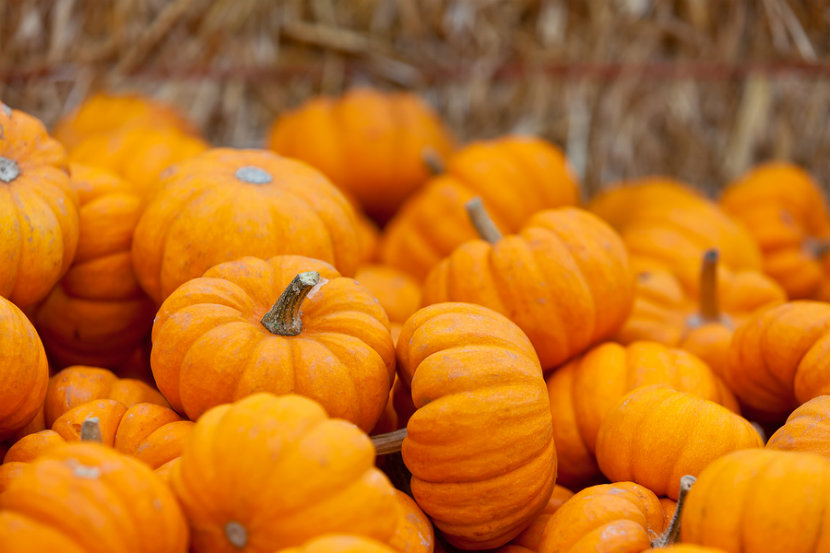
Pumpkins are a popular fall vegetable and are fun to carve on Halloween. Pumpkins are also tasty and nutritious! Both the seeds and the flesh can be used in many interesting dishes. All good reasons to remember to eat pumpkin the rest of the year.
Nutrition spotlight on pumpkins!
Pumpkin is an excellent source of vitamin A. Vitamin A helps your eyes and skin stay strong and healthy. As an antioxidant, vitamin A can help you lower the risk of some diseases and fight signs of aging. Pumpkin is also a good source of fibre which helps keep your digestive system healthy and prevent some chronic diseases.
Pumpkin seeds are an excellent source of iron and are rich in protein.
Buying local pumpkins
Pumpkins are grown in Canada and are available in September and October. When you buy local food, you support farmers so they can keep producing high quality, affordable food we can all enjoy.
Shopping and storing for pumpkins
The best pumpkins for cooking are the small pie pumpkins, which have a smoother texture and flavour than the larger ones. Look for pumpkins with firm and smooth orange skin and that feel heavy for their size. Avoid pumpkins with cracks and bruises.
Whole pumpkins can be kept in a cool, dry place for several months. Once you cut up your fresh pumpkin, store it in the refrigerator wrapped in plastic and use within five days. Cooked pumpkin can be frozen for up to 10 months.
Preparing pumpkin
Most dishes can be made with fresh, frozen or canned pumpkin. Pumpkin is tasty in casseroles, soups, as a filling in dumplings or perogies, in breads, muffins, pies and other baked goods.
Pumpkin is a good substitute in any recipe that calls for butternut squash or other vegetables of the winter squash family. In a recipe, one cup of fresh pumpkin will cook to one cup of mashed pumpkin.
The easiest way to prepare pumpkin is to:
-
Wash it with damp cloth
-
Carefully cut it open using a sharp knife
-
Scoop out the seeds and the fibre strands from the centre and discard or save the seeds for roasting
-
Then prepare according to recipe instructions
Cooking pumpkin
Pumpkin can be baked, boiled, steamed or cooked in the microwave. Once cooked, the flesh can easily be scooped from the hard outer peel and then mashed or pureed.
Pumpkin seeds
Pumpkin seeds make a tasty and healthy snack. Wash them to remove any bits of flesh, season, then spread on a baking sheet and roast in the oven at 350 °C until golden brown and crunchy (about 15 minutes, tossing every 5 minutes).
Make cooked pumpkin or seeds taste great by using any or a combination of these flavours: allspice, cardamom, cinnamon, nutmeg, cloves, ginger and cumin.
To get more pumpkin on your table, give these recipes a try:
Hearty Manitoba Vegetable Soup
Pumpkin Cranberry Muffin Squares
No Bake Chocolate Almond Bliss Bars
Mango Banana Smoothie Bowl
How can a dietitian help?
Dietitians can support you throughout many phases of your life from pregnancy to eating well when you are older. Counselling sessions with a dietitian can also help you to prevent and treat health conditions like diabetes and heart disease. Your dietitian will work with you to give you personalized advice that meets your lifestyle and goals. Connect with a dietitian today!
Bottom line
Fresh, frozen or canned pumpkin makes a great addition to meals or baked goods. Pumpkin is an excellent source of vitamin A and contains fibre and other important nutrients. Don’t forget to save the seeds of the pumpkin as they are packed full of nutrients too!
You may also be interested in:
What You Need to Know About Vitamin A
Focus on Fibre
Top 5 Reasons to See a Dietitian
This article was written and reviewed by dietitians from Dietitians of Canada. The advice in this article is intended as general information and should not replace advice given by your dietitian or healthcare provider.
Last Update – February 12, 2023